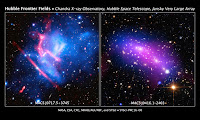Latest astrophysics news
 Rotation curves of galaxies as a test of MOND?
Rotation curves of galaxies as a test of MOND?
Galaxies are rotating with such speed that the gravity generated by their observable matter could not possibly hold them together. In a recent paper (Haghi et al. 2016) the authors test the Modified Newtonian Dynamics (MOND). Read>>
A binary origin for a central compact object (CCO)?
Doroshenko et al. 2016 investigate the possible binary origin of the CCO XMMUJ173203.3-344518. Read>>
Rapidly rotating pulsars as possible sources of fast radio bursts (FRB)
In a recent paper (Lyutikov et al. 2016) the authors discuss possible association of fast radio bursts (FRBs) with supergiant pulses emitted by young pulsars. Read>>
Supernovae from WD-WD direct collisions
In recent years it was suggested that WD-WD direct collisions (probably extremely rare and occurring only in dense stellar clusters) provide an additional channel for supernova explosions. Read>>
Telescopes Combine to Push Frontier on Galaxy Clusters
Hubblesite news. Read>>
No correlation between Fermi GBM signal and GW150914.
The electromagnetic signal detected by Fermi GBM is likely unrelated to the BH merger detected by LIGO. Read>>
 Rotation curves of galaxies as a test of MOND?
Rotation curves of galaxies as a test of MOND?Galaxies are rotating with such speed that the gravity generated by their observable matter could not possibly hold them together. In a recent paper (Haghi et al. 2016) the authors test the Modified Newtonian Dynamics (MOND). Read>>
A binary origin for a central compact object (CCO)?
Doroshenko et al. 2016 investigate the possible binary origin of the CCO XMMUJ173203.3-344518. Read>>
Rapidly rotating pulsars as possible sources of fast radio bursts (FRB)
In a recent paper (Lyutikov et al. 2016) the authors discuss possible association of fast radio bursts (FRBs) with supergiant pulses emitted by young pulsars. Read>>
In recent years it was suggested that WD-WD direct collisions (probably extremely rare and occurring only in dense stellar clusters) provide an additional channel for supernova explosions. Read>>
Telescopes Combine to Push Frontier on Galaxy Clusters
Hubblesite news. Read>>
No correlation between Fermi GBM signal and GW150914.
The electromagnetic signal detected by Fermi GBM is likely unrelated to the BH merger detected by LIGO. Read>>





Comments
Post a Comment